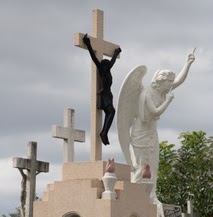 In partnership with the Episcopal Diocese of Missouri, we have just launched Each Other’s Keeper For Individuals and For Groups.
In partnership with the Episcopal Diocese of Missouri, we have just launched Each Other’s Keeper For Individuals and For Groups.
This curriculum has emerged from the Episcopal Diocese of Missouri’s years of effort to reduce violence and to support victims of violence in their community.
Over the past few years, the Diocese of Missouri has focused much attention on resisting violence and mitigating effects of violence in its communities, particularly in St. Louis. It emerged from an anti-violence campaign the diocese instituted in the wake of the shooting of Michael Brown and in the context of increasing violence in the community. It was written and put together by the Rev. Marc Smith, appointed in 2015 to lead diocesan efforts to reduce gun violence and coordinate intervention work with others in the region.
Now, in an effort to bring this curriculum to anyone who wants to learn about mitigating the effects of violence in their own communities, they have adapted it for a national audience.

The curriculum’s first section addresses violence in scripture. In a series of books very focused on violence — in which pivotal incidents like the invasion of Canaan in the Old Testament and the crucifixion in the New Testament depend on violence — what are Christians to understand when Christ asks us to turn the other cheek? What can we learn about following Christ in relation to violence when we read scripture?
 The second section deals with gun violence. Incidents of suicide, domestic violence, homicide, and accidental shootings, as well as the incidents of public mass murder we read about so often, all grow with our access to firearms. Because the ways gun violence emerges in the community vary, our laws should address gun regulations with a more precise focus on different types of gun violence, why they happen, and the best ways to reduce each type of gun violence. This section asks, how can Christians help communities address gun violence regulations with the precision and care the topics require?
The second section deals with gun violence. Incidents of suicide, domestic violence, homicide, and accidental shootings, as well as the incidents of public mass murder we read about so often, all grow with our access to firearms. Because the ways gun violence emerges in the community vary, our laws should address gun regulations with a more precise focus on different types of gun violence, why they happen, and the best ways to reduce each type of gun violence. This section asks, how can Christians help communities address gun violence regulations with the precision and care the topics require?

The third section focuses on youth bullying and suicide. It draws connections between ways and reasons young people experience bullying and suicide rates. It also looks at suicide itself — why people, particularly young people, make this choice, effective ways for communities to support people at risk for suicide, and ways to reach out to survivors.

The fourth section addresses violence against women, focusing in particular on domestic violence and sexual assault. Its goals: to educate people about the challenges abuse and assault survivors face and to educate churches on create environments that ensure that all are kept safe from harm, hold abusers accountable, and embrace those who have survived.

The fifth section discusses forgiveness and reconciliation. In the Lord’s Prayer, we ask God to help us forgive those who sin against us — but the need to forgive, especially when forgiveness is demanded of them, can become an additional burden on people who have been abused. How can we treat victims of violence with respect for what they have endured while also embracing forgiveness? How can we model reconciliation on the level of the wider culture while also holding oppressors and instigators of violence accountable for their actions?
This curriculum is perfect for Christians interested in interrupting cycles of violence in their communities or in supporting survivors of various forms of violence. We hope you will emerge with a greater understanding of the complexities related to violence in its various forms and with a sense of where you might go next in your efforts to interrupt the cycles of violence so prevalent in our culture today.
All of the above photographs were taken for this curriculum by the Rev. Anne Kelsey.
